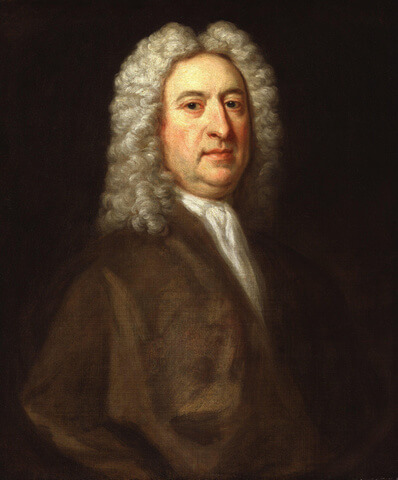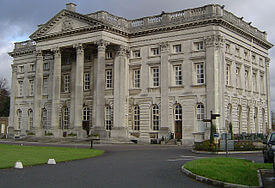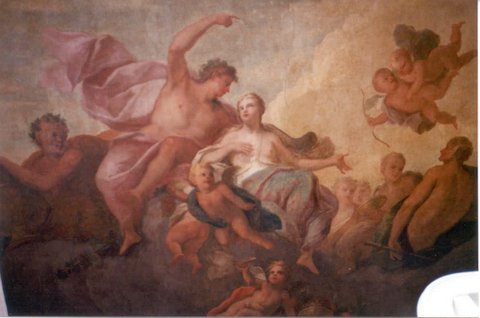This article was written by Michael Brooks in 2013 and is reproduced with his permission
SIR JAMES THORNHILL’S WORK IN THE AMERSHAM AREA
 James Thornhill was born at Melcombe Regis in 1675. Despite coming from a humble background he was the only English decorator in the Grand Baroque style – competing with foreign painters such as Verrio, Laguerre, Sebastiano Ricci, Pellegrini and Amiconi. He had particular expertise in the painting of ceilings, which was very time-consuming and could only be carried out in daylight as it was impossible to use oil-lamps or candles.
James Thornhill was born at Melcombe Regis in 1675. Despite coming from a humble background he was the only English decorator in the Grand Baroque style – competing with foreign painters such as Verrio, Laguerre, Sebastiano Ricci, Pellegrini and Amiconi. He had particular expertise in the painting of ceilings, which was very time-consuming and could only be carried out in daylight as it was impossible to use oil-lamps or candles.
His first major commission was for decorating the Painted Hall at Greenwich Hospital, begun in 1708, which was to take him 19 years to complete. (At the time of writing, his work there is being restored at an estimated cost of 2½ million pounds.)
The next major commission he undertook was for painting the inside of the cupola of St Paul’s Cathedral, which Sir Christopher Wren had completed in 1715. He completed this within 2 years. He proceeded to carry out major work at Hampton Court, Kensington and Blenheim Palaces, London Guildhall, Chatsworth, Hanbury Hall, Sherborne and many other stately homes. [Click here to see a BBC slide-show of 89 of his paintings.]
 He worked more locally at Moor Park in Rickmansworth, where Benjamin Haskyn Styles appointed him as Surveyor & Architect to re-model the old Mansion which he had purchased with 3,000 acres from the Duchess of Monmouth in 1720. Styles, a City trader, had made a fortune in the South Seas Company before the bubble burst and wished to show his new position in society by up-dating the brick building to make it a grand Palladian-style mansion. Thornhill worked at Moor Park on and off, until 1728.
He worked more locally at Moor Park in Rickmansworth, where Benjamin Haskyn Styles appointed him as Surveyor & Architect to re-model the old Mansion which he had purchased with 3,000 acres from the Duchess of Monmouth in 1720. Styles, a City trader, had made a fortune in the South Seas Company before the bubble burst and wished to show his new position in society by up-dating the brick building to make it a grand Palladian-style mansion. Thornhill worked at Moor Park on and off, until 1728.
Around 1729 Thornhill was approached by Charles Eeles of Amersham and asked to paint a ceiling and other panels for his newly built house in the High Street. Charles Eeles had catering and other business interests in London and is described as being “a citizen and cook of London”. Thornhill was a great gourmand and a note-book exists which describes meals he had eaten there, and it may well be that they met at some banquet. Eeles built his Amersham House (known variously as No.42 High Street, Amersham Hall, Woodville House and now Elmodesham House) as a symbol of his rising status in life, though curiously, it seems that he never actually lived in the house which passed to his nephew, Isaac, in 1747.
 The beautiful ceiling in Elmodesham House, depicting Bacchus and Ariadne on Naxos, was originally painted for Charles’s dining room, but after a major re-construction of the house after 1747 the staircase was moved and the ceiling is now to be found above the main staircase. Panels painted in the drawing room and the principle bedroom on the first floor survived the re-construction but were papered over when the house became ‘the Academy for the sons of Liberal Gentlemen’ in 1829. They were ‘lost’ until the major re-construction by Harman in 1986 when the house was converted into flats. Harman had the re-discovered panels restored as they were damaged, only for the best of them to be cut out and stolen. They have never been traced. Four panels survive.
The beautiful ceiling in Elmodesham House, depicting Bacchus and Ariadne on Naxos, was originally painted for Charles’s dining room, but after a major re-construction of the house after 1747 the staircase was moved and the ceiling is now to be found above the main staircase. Panels painted in the drawing room and the principle bedroom on the first floor survived the re-construction but were papered over when the house became ‘the Academy for the sons of Liberal Gentlemen’ in 1829. They were ‘lost’ until the major re-construction by Harman in 1986 when the house was converted into flats. Harman had the re-discovered panels restored as they were damaged, only for the best of them to be cut out and stolen. They have never been traced. Four panels survive.
Sir Oliver Millar, when Keeper of the Queen’s Pictures, considered that the ceiling was definitely the work of Thornhill himself but that the other panels were the work of his students and assistants. The house was one of the very few private residences where Thornhill’s work is found. Another is Sherborne House, Grade I listed, in Dorset. The magnificent Baroque-style mural there is, at the time of writing, undergoing expensive restoration. Some of the figures depicted show marked similarity to the Amersham ceiling.
Thornhill was Queen Anne’s favourite painter. King George I appointed him Court Painter in 1718 and then Sergeant Painter to the Sovereign in 1722 when he was also knighted. Besides all his architectural and decorative work, Sir James also became Member of Parliament for Melcombe Regis in 1722 and was to represent that constituency until his death. In 1723 he was elected a Fellow of the Royal Society and he was also the Master of The Painter-Stainers Company. After 1730 he gave up decorating work to concentrate on house design and his Parliamentary constituency, and also because he suffered with arthritis made worse from spending long periods lying on his back to paint ceilings.
Thornhill had a son, John, and a daughter, Jane, who married the painter William Hogarth. A portrait of Thornhill by Hogarth may be seen in the British Library and there is a self-portrait in the St. Paul’s Cathedral collection.
Sir James Thornhill died intestate in 1734 “sitting in his chair” at Thornhill, Stalbridge in Dorset.
In 1735 Thornhill’s large and valuable art collection was sold by Dame Judith and the family. The sale included 16 cartoons “as large as life” of Apostles and Evangelists. These had been created by Thornhill in 1722 for a replacement of the Great Rose Window in Westminster Abbey, which had been re-designed y Sir Christopher Wren and Dean Atterbury. This magnificent window had to be replaced again in 1890, again using Thornhill’s designs but cut down to fit new tracery. The original cartoons may be seen in Chinnor Church. Thornhill received £100 for painting the cartoon figures.
ADDENDUM
When contracting for work, Thornhill estimated the decorative costs by the area to be covered. He received 40/- per square yard for the work at Greenwich Hospital and a similar amount for the work at St Paul’s Cathedral. For work at Blenheim Palace he only received 25/- per square yard. He quoted a higher figure for work to be carried out on the hall and staircase at the South Seas Company London house. However, the Company Director, on hearing that he had only been paid 25/- at Blenheim contested his bill and he had to settle for that rate.
Benjamin Styles at Moor Park fell out with Thornhill over the standard of the decorative work in the main hall at the mansion. A law suit followed. Thornhill brought in Dahl, Richardson and others to give evidence as to the merit of the work. Styles was forced to pay up but much of Thornhill’s work was replaced by Amiconi who came to Britain in 1729. Only the wonderful trompe-l’oeil ceiling survives, though other panels depicting victorious Generals were discovered years later in one of the bedrooms at the mansion.
It has not been possible to determine the cost of Thornhill’s work at Elmodesham House. As the house is now flats, public access is not possible, though on Heritage Day in 2012 parties were allowed to view the ceiling at booked times.
REFERENCES
- ·History of Elmodesham, by the author, and other research material in Amersham Museum
- ·Chambers Book of Days 1869; i.591
- ·Dictionary of Art. Artists 1959
- ·Moor Park. Martyn Pedrick 1986
- ·Moor Park Mansion. Susan Bennett and NADFAS Volunteers 2012
- ·A pictorial guide to St Andrew’s Church, Chinnor 2013
- ·The history of the Abbey Church of St Peter, Westminster 1812

